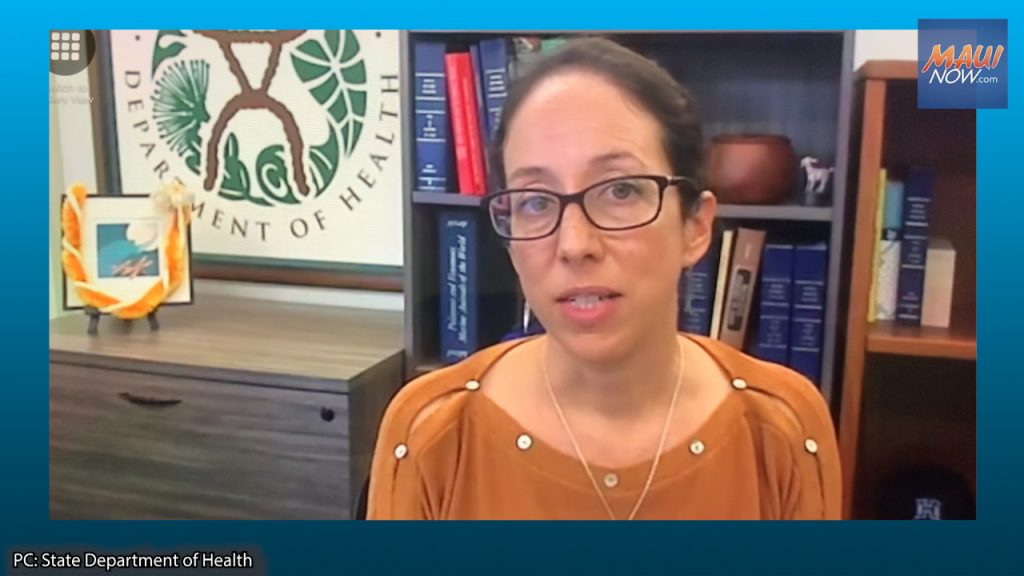DOH Updates: Today’s COVID Count, Pediatric Cases, Mu Variant, and Boosters

Hawaiʻi State Epidemiologist Dr. Sarah Kemble answered media questions on Tuesday afternoon about today’s COVID-19 count, pediatric and breakthrough cases, the mu variant and booster shots. During a brief Zoom update, state health officials provided some updates on what we’re seeing now and what we can expect in the weeks ahead.
What today’s case count tells us:
There were 499 additional COVID-19 cases in Hawai‘i on Tuesday. The latest data represents a total of 11,265 “active” cases over two weeks.
“Today our daily new cases seven-day average is at 706–this may indicate a slight reprieve in the numbers that we’ve seen, but we’re definitely not out of the woods yet,” said state epidemiologist Dr. Sarah Kemble. “We are continuing to see very high numbers of cases. Remember that a month ago, 700 would be an incredibly alarming case count for our islands. We also know that there is a lag still, between when we see cases, and when we see hospitalizations and deaths. And tragically, we do anticipate seeing many more deaths reported out in the coming weeks from the cases that we’ve already learned about.”
“The hospitals, as you know, continue to address critical issues with shortages, whether it’s addressing a shortage in oxygen last week, shortages in beds, and continuing to try to provide excellent care to those patients who are coming into our hospitals,” said Dr. Kemble.
“Another factor that we have to consider is some variations in testing from time to time. So, holiday weekend–I’m not sure that people were out in droves to test as they might have during other times. So I think we really need to see how things unfold in the coming week before drawing conclusions about where the case numbers are,” said Dr. Kemble.
“In the meantime, I do hope that people will have taken to heart the mitigation guidance about keeping in your households, avoiding large gatherings, staying home when you’re sick, and if we can continue to do that, we could see a true decrease in the case trends, which is going to be much needed,” said Dr. Kemble.
Pediatric Cases :
“We are seeing more cases now than ever among pediatric populations. About a quarter of our cases at last look. Part of that is related to the overall rise in cases. So as the total number cases go up, we’re going to see more children who are diagnosed and who ultimately end up in the hospital, just because the overall numbers are increasing. But we’re also seeing that creeping up a little bit, as a proportion of all cases. This may be partly driven by vaccine because the groups that are left that don’t have eligibility for vaccination are our youngest children. So we are seeing some increase in proportion in cases in that group, which is our unprotected group,” said Dr. Kemble.
“When we do try to look at the severity of illness, we’re still tracking what the national case hospitalization proportion has been, about 2%–that’s still what we’re seeing in Hawaiʻi too. So we aren’t seeing an increase in severity of illness among these pediatric cases, but we are seeing more children infected,” said Dr. Kemble.
Since the start of the pandemic there has been just one pediatric COVID-19 death in Hawaiʻi. In April, 2021, we reported a death involving a boy between 0 and 10 years old who experienced COVID-19 symptoms shortly after arriving in the islands. He had known underlying health conditions and was visiting Hawai‘i with his parents from another state.Both parents were fully vaccinated before making the trip to Hawai‘i.
Breakthrough Cases:
As of Aug. 26, the state Department of health had documented 2,419 breakthrough cases in Hawaiʻi. “This makes up about 7% of all COVID cases in the state since January, and about 0.3% of the fully vaccinated population,” said Dr. Kemble.
“Part of how we ascertain breakthrough cases is by case investigation. We have to call people and ask them if they’ve been vaccinated. So this is likely an undercount of the true numbers, because we don’t reach everyone to find out that information. But we do have a better look at it when we look at who is in the hospital because usually those people have their vaccine records reviewed. So we do hear from the hospitals and we’re seeing maybe 10% to sometimes 15% of those in the hospital who are vaccine breakthrough cases,” said Dr. Kemble.
“I think there’s a couple of things that you have to keep in mind when you think about vaccine breakthrough cases. One is the more we have infection circulating around us, the more breakthrough cases we will see because while we do know that vaccines work–they’re highly effective at preventing hospitalization and death–they don’t prevent every infection from occurring,” said Dr. Kemble. “And if you have enough infection pressure around you because you’re surrounded by infected people, you will have some of those breakthrough cases. Where we tend to see more of the hospitalizations are in older individuals and those with multiple co-morbidities. These are people who might land in the hospital after getting the common cold sometimes or other common viruses like influenza. So, some of that is to be expected even though it is unfortunate.”
Mu Variant:
“We have had a few cases of mu variant here in Hawaiʻi detected through our whole genome sequencing program with the state Laboratories Division. Also, those were detected back in June. Similar to other jurisdictions that have seen mu, we saw a few cases during that summer time period that seemed to have subsided at this point. We’re not seeing continued detection in the most recent runs. Mu has not been called out by the CDC at this point as a variant of concern. It’s not one of the ones that we have tracked on the variant report, which is why you may not have seen it there,” said Dr. Kemble.
“Part of what make a variant a variant of concern, is not just the characteristics about that particular strain, but also what’s the propensity of that strain to take over and become the dominant strain,” said Dr. Kemble. “We’re not seeing that with mu. We’re really seeing that delta seems to have found its niche here and that’s still well over 95% of the cases that we’re seeing in the state. So our current problems are really driven by delta, not mu.”
Booster Shots:
“Right now, booster shots are something that we’re trying to distinguish from the third dose that you would give to an immunocompromised individual. The ACIP–the Advisory Committee on Immunization Practices–has come out with recommendations that if you are severely immunocompromised– if you have cancer and are on chemotherapy, if you’re taking really high dose steroids every day, certain conditions that would make it difficult for your body to mount the initial immune response–three doses is recommended instead of two,” said Dr. Kemble, noting that’s the only current recommendation for additional doses beyond the two dose series for mRNA vaccine.
“For booster shots, we are all awaiting further review of the data and Emergency Use Authorization from the FDA before providing recommendations on boosters for the general population,” said Dr. Kemble. “There’s a couple of reasons why I wouldn’t recommend running out today to get your booster shot. One is that we still don’t have great information on when to get it, what the impact’s going to be, which populations are going to benefit from it. There’s a lot of unknowns out there that we still don’t know about boosters.”
“What we do know right now is that if you haven’t had a single shot of vaccine, you will greatly benefit by getting that full series done now,” said Dr. Kemble, saying the unvaccinated population is a first priority for vaccinations.









